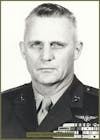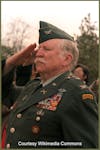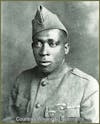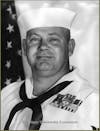Gen. Joshua Chamberlain: The Lion of the Round Top at Gettysburg & Medal of Honor Recipient
Discover the fascinating story of US Army General Joshua Chamberlain, who faced the brink of defeat before leading his men to a heroic counteroffensive that secured the Union flank during the pivotal Battle of Gettysburg. It ...
Discover the fascinating story of US Army General Joshua Chamberlain, who faced the brink of defeat before leading his men to a heroic counteroffensive that secured the Union flank during the pivotal Battle of Gettysburg. It took 30 years for him to be awarded the Medal of Honor for his outstanding leadership in the US Civil War. Join us as we honor and share his inspiring story.
Please visit our website to learn more about him, and other American Heroes.
www.dutyandvalor.com
Sources:
Wikipedia
Biography.com
Battlefields.org
DefenseMediaNetwork
Themusa.org
Thank you for listening to Duty & Valor!
Music by Amelie Leclerc. Artist's other music can be found here.
Please follow us on your favorite social media site.
Facebook
Instagram
Twitter
YouTube
Welcome back everyone. On today's episode of Duty & Valor you’ll hear the story of a man who left his teaching career behind to fight in some of the most deadly battles of the Civil War. A man who led a heroic charge in a defining moment of the Battle of Gettysburg. A man who seemed to return from the dead to lead his men in battle. This is the story of Medal of Honor Recipient US Army Gen. Joshua Chamberlain.
Lawerence Joshua Chamberlain, who would go by Joshua, was born on September 8th, 1828 the oldest of five children born to parents Sarah and Joshua Sr. of Brewer, ME. The influence of his father, who wanted Joshua to be a military man, and his mother who wanted him to become a minister, would shape the man who became one of the more prominent Union Civil War officers. He attended a military school before teaching himself Greek so he could attend Bowdoin College. While at Bowdoin, he taught Sunday school and became his church’s choir director. After graduating, he then entered the Bangor Theological Seminary, and there he learned Latin, German, French, Arabic, Hebrew, and Syriac.
In December 1855 he met, then married, Frances “Fanny” Adams and the two would go on to have two surviving children, daughter Grace and son Harold. Soon after he returned to Bowdoin to teach, and he was still there when the Civil War started. From the start he believed that the Union should be preserved, and should be supported by all in the North, which was an unpopular opinion among his colleagues.
He was offered the Colonelcy of the 20th Maine Regiment, but he declined. It was written that he said he wanted to “start a little lower and learn the business first.” He did accept the rank of Lt. Col. and was second in command under Col. Adelbert Ames, and the 20th Maine was now part of the 3rd Brigade, 1st Division, Fifth Corps of the Army of the Potomac.
Chamberlain and the 20th took part in the Battle Fredericksburg in December of 1862, and fared well during the assaults on Marye’s Heights and they suffered very few casualties. In May of the next year, 1863, the 20th was suffering a smallpox outbreak so they were relegated to rear guard duty during the Battle of Chancellorsville.
Fresh off of recent victories, including at Chancellorsville, the Confederate Army of Northern Virginia pushed into Pennsylvania in an attempt to kill support for the war in the North. They were able to advance as far North as Gettysburg when they met the newly appointed commander, General Meade, and the Army of the Potomac. The two advancing armies made contact with each other on July 1st. The Confederate Army had the early advantage and pushed the lead elements of the Union Army into the hills south of town. By the second day of the battle both armies had been reinforced by their remaining forces, which set the stage for a major battle.
By this point the 20th was back to fighting form and Chamberlain, now a Col., was given the order to take the regiment to set up position on a nearby hill, called Little Round Top. He was also made to understand the importance of this position. The 20th was given the important task of securing the Union extreme left flank, and they had to secure it at all costs. The hill was rocky and tree covered so some thought an attack there wasn’t possible, but they were wrong.
Col. Oates of 15th Alabama Infantry Regiment, as well as the Alabama 47th Infantry, were given orders to flank the Union Army. The Confederate forces knew it wouldn’t be an easy task, but they thought they could overpower the 20th and collapse the whole Union line upon itself.
The men of the 20th were able to repulse repeated assaults by the Alabama men, but it wasn’t easy and they were struggling.
Their once stout defensive line was bending and the leftmost element of their formation was bending back onto itself. Their line was now facing West and SouthEast. They were able to hold their line in the face of more attacks, six assaults in total, but they were now exhausted, suffering from many casualties, and extremely low on ammunition. So low that some of the men had no ammo at all.
Seeing that the attackers were forming to assault the hill again, Col. Chamberlain wasn’t sure if the men of the 20th could hold the line if they faced another attack. He then yelled the one word that would communicate to his men what needed to be done. “Bayonets!”.
Chamberlain knew that they had a very small chance to catch the Confederate forces off guard if they could hit them before they were fully reformed. He ordered the left of his line to advance first and move to reform a straight line. This movement, followed by the direct advance from the remainder of his line, gave their attack a hinge-like action, which gave them the advantage of a frontal and flanking attack.
With his saber drawn, Col. Chamberlain led his men directly at the shocked men at the bottom of the hill. When they made contact and were fighting in close quarters, a Confederate officer took aim at Chamberlain with his revolver and just missed hitting him in the face. Before he could get a second shot off, Chamberlain raised his sword to the man’s neck and asked for his surrender. The officer did surrender and gave Col. Chamberlain his revolver.
The men of the 20th were able to capture hundreds of Confederate soldiers and forced the remaining men to retreat. The left flank was then reinforced by General Weed’s men, thus ensuring no other Confederate attack would be attempted. During this battle, Col. Chamberlain only suffered a minor injury when his sword scabbard was hit by an enemy round, bruising his thigh. It was also reported that Chamberlain was still recovering from malaria and dysentery during the battle. For his actions that day, he was given the nickname “The Lion of the Round Top” and was finally awarded the Medal of Honor 30 years later.
Col. Chamberlain recovered from his illness and returned to the Army in April 1864 and he was given command of the brigade. On June 18th, he was leading his men at the second Battle of Petersburg when he was shot in the right hip. The bullet traveled through his body, hit his groin and exited his left hip. Knowing what it would do to morale if his men saw him fall, he drew his saber and stuck it into the ground and used it to prop himself up as he continued to give commands, but he was losing a lot of blood and after a few minutes fell to the ground unconscious.
The Union surgeons overseeing his care gave the news that his wounds were mortal, and on the following day, General Grant gave him a battlefield promotion to Brigadier General. The people of Maine were shocked to read about the death of their local hero, but the real shock came when they read a correction in the newspaper that General Chamberlain had actually survived his wounds. Against the wishes of many, including his wife, he decided to remain in the Army until the conclusion of the war.
After months of recovery, Gen. Chamberlain regained command of the Brigade in early 1865. On March 29, the brigade was part of the final Union advance of the war, when they were involved in the Quaker Rd. skirmish in Virginia. He was shot in his chest and left arm, which was almost amputated and he was nearly captured. Later on he was once again shot. A Confederate soldier had hit him in the left chest, but luckily it struck the metal framed picture of his wife that he kept in his pocket. Although it appeared to all that his chest took a direct hit, the bullet actually penetrated his skin and followed his rib cage before exiting his back. He was able to stay in the fight and lead his men on.
On the morning of April 9th, Gen. Chamberlain was approached by Gen. Gordon of the Confederate army, who was waving a white flag. He stated that General Lee was asking for a ceasefire while terms for surrender were discussed.
Gen. Chamberlain and his men were the ones chosen to receive the arms and colors of the surrendering Confederate infantry on April 12th. In one of his last commands of the war, Gen. Chamberlain ordered his men to attention, as the Confederate soldiers marched to turn in their weapons.
He said that there was no “sound on our part, not a sound of trumpet or drum, not a cheer, nor a word nor motion of man, but awful stillness.” It was no surprise that many in the Union Army did not like this show of respect.
During the war, General Chamberlain was involved in 20 battles and many major skirmishes. He had a horse shot out from under him on six occasions. He also survived six wounds, some of which could have killed him.
After the war ended he returned to Maine. He served as a Major General in the Maine National Guard, and would go on to be elected Governor of Maine where he served four consecutive one year terms. He then went on to serve as the President of Bowdoin College.
On Feb. 24th, 1914, at the age of 85, General Joshua Chamberlain died due to complications of the wounds he suffered at Petersburg. He was the last Civil War veteran to die of wounds sustained in the war.
He is buried at the Pine Grove Cemetery in Brunswick Maine.
Thank you for listening to this episode of Duty & Valor. If you enjoy the podcast, we ask that you follow us and leave a review or 5 star rating, which will help us find new listeners.
Links to the sources for today's show can be found in the show notes, as well as at dutyandvalor.com. And please join us next week where we’ll tell you the story of another true American hero.




















